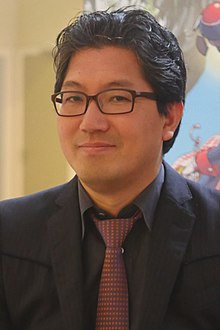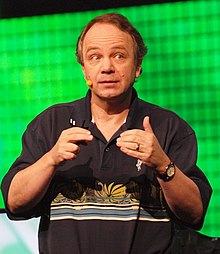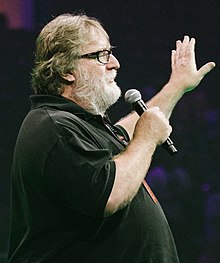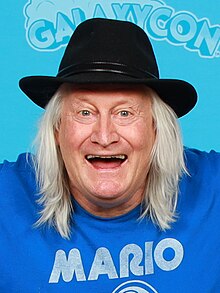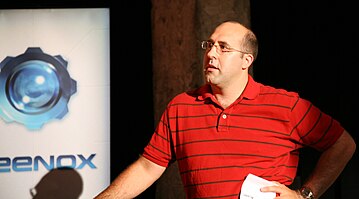Portal:Video games
The Video Games Portal

A video game, also known as a computer game or just a game, is an electronic game that involves interaction with a user interface or input device (such as a joystick, controller, keyboard, or motion sensing device) to generate visual feedback from a display device, most commonly shown in a video format on a television set, computer monitor, flat-panel display or touchscreen on handheld devices, or a virtual reality headset. Most modern video games are audiovisual, with audio complement delivered through speakers or headphones, and sometimes also with other types of sensory feedback (e.g., haptic technology that provides tactile sensations). Some video games also allow microphone and webcam inputs for in-game chatting and livestreaming.
Video games are typically categorized according to their hardware platform, which traditionally includes arcade video games, console games, and computer (PC) games; the latter also encompasses LAN games, online games, and browser games. More recently, the video game industry has expanded onto mobile gaming through mobile devices (such as smartphones and tablet computers), virtual and augmented reality systems, and remote cloud gaming. Video games are also classified into a wide range of genres based on their style of gameplay and target audience. (Full article...)
Featured articles –
Flight Unlimited was the first self-published game released by Looking Glass Technologies. It was intended to establish the company as a video game publisher and to compete with flight simulator franchises such as Microsoft Flight Simulator. Project leader Seamus Blackley, a particle physicist and amateur pilot, conceived the game in 1992. He felt that other flight simulators failed to convey the experience of real flight, and he reacted by coding a simulated atmosphere for Flight Unlimited based on real-time computational fluid dynamics. Aerobatic pilot Michael Goulian endorsed the game and assisted the team in making it more true to life.
Flight Unlimited received positive reviews from critics and was a commercial success; its sales exceeded 780,000 copies by 2002. Reviewers lauded its realism, flight instruction, graphics and sense of flight, but some criticized its high system requirements. The game was followed by two sequels: Flight Unlimited II (1997) and Flight Unlimited III (1999). A combat-oriented successor, Flight Combat, was released in 2002 as Jane's Attack Squadron after a series of setbacks. Soon after Flight Unlimited's completion, Blackley was fired from Looking Glass. He went on to design Jurassic Park: Trespasser at DreamWorks Interactive and later spearhead the Xbox project at Microsoft. (Full article...)
Programmer Ed Salvo was inspired to make Lost Luggage when he was waiting for his luggage at the Dallas/Fort Worth International Airport, and the game took around four weeks to produce. Reviewers criticized the game's similarity to Activision's Kaboom!—which itself is based on the arcade game Avalanche—believing Lost Luggage to be an inferior clone. (Full article...)
Lead designer Peter James described Flight Unlimited III's development as a struggle, thanks to a lack of interest from Electronic Arts and from Looking Glass's management. Placed in direct competition with Microsoft Flight Simulator 2000 and Fly!, the game failed to capture sufficient market share. It became one of Looking Glass's biggest commercial flops, with roughly 20,000 units sold in the United States during 1999. This contributed to the company's closure in 2000. The game was well received by critics, who praised its terrain rendering and dynamic weather. Its simulated physics were lauded by several reviewers, but others felt that the physics were imprecise and that the game's system requirements were extremely high. (Full article...)
The game was conceived in 1985 by Ron Gilbert and Gary Winnick, who sought to tell a comedic story based on horror film and B-movie clichés. They mapped out the project as a paper-and-pencil game before coding commenced. While earlier adventure titles had relied on command lines, Gilbert disliked such systems, and he developed Maniac Mansion's simpler point-and-click interface as a replacement. To speed up production, he created a game engine called SCUMM, which was used in many later LucasArts titles. After its release, Maniac Mansion was ported to several platforms. A port for the Nintendo Entertainment System had to be reworked heavily, in response to Nintendo of America's concerns that the game was inappropriate for children.
Maniac Mansion was critically acclaimed: reviewers lauded its graphics, cutscenes, animation, and humor. Writer Orson Scott Card praised it as a step toward "computer games [becoming] a valid storytelling art". It influenced numerous graphic adventure titles, and its point-and-click interface became a standard feature in the genre. The game's success solidified Lucasfilm as a serious rival to adventure game studios such as Sierra On-Line. In 1990, Maniac Mansion was adapted into a three-season television series of the same name, written by Eugene Levy and starring Joe Flaherty. A sequel to the game, Day of the Tentacle, was released in 1993. (Full article...)
Did you know... -
- ... that Paul Dini was a writer for both the animated television series Batman: The Animated Series and the video game series Batman: Arkham?
- ... that before Sarah Elmaleh voiced the player character in the video game Anthem, developed by BioWare, she voiced characters in a mod of an earlier BioWare game?
- ... that a version of the video game Rhino Rumble was not released due to the creators not wanting to add licensed characters?
- ... that the Chicago Sun-Times credits JumpStart Toddlers as the first video game targeted towards babies?
- ... that the video game Serious Sam: Tormental was originally inspired by Geometry Wars?
- ... that Through the Darkest of Times was the first video game published in Germany to use swastikas?
- ... that a cheat code in the video game Spyro: Year of the Dragon grants access to a near-complete copy of Crash Bash?
- ... that Kamibox's video game A Joke That's Worth $0.99 is permanently on special offer because Itch.io does not allow $0.99 as a regular price?
- ... that Elena from the video game series Street Fighter uses a capoeira fighting style, for which the development team used travel videos as reference material as they had no experience with the style?
- ... that the developers of the video game Golf Club: Wasteland jokingly announced that they would only sell one copy at a price of $500 million?
- ... that a pink skin for Mercy in the video game Overwatch helped raise more than $12 million for breast cancer research?
- ... that the urban legend Herobrine was ranked on a Guinness World Records poll of the best video game villains, despite never existing?
Selected biography –
Selected image -
Recent video game-related events
- September 12, 2024 – 2023–2024 video game industry layoffs
- Microsoft announces that it will lay off 650 Microsoft Gaming employees as part of cuts to its workforce. (Variety)
- August 15, 2024 –
- American video game magazine Game Informer discontinues publication after 33 years. The magazine's website is also shut down. (BBC News)
- May 24, 2024 – Uvalde school shooting
- Families in Uvalde, Texas, U.S., file a lawsuit against Daniel Defense and Activision Blizzard for creating the DDM4 V7 gun and promoting the weapon through the game Call of Duty, respectively. They also sue Meta Platforms for owning Instagram, which was used by the gunman. (AP)
Topics
Categories
Things you can do
In other Wikimedia projects
The following Wikimedia Foundation sister projects provide more on this subject:
-
Commons
Free media repository -
Wikibooks
Free textbooks and manuals -
Wikidata
Free knowledge base -
Wikinews
Free-content news -
Wikiquote
Collection of quotations -
Wikisource
Free-content library -
Wikiversity
Free learning tools -
Wiktionary
Dictionary and thesaurus








